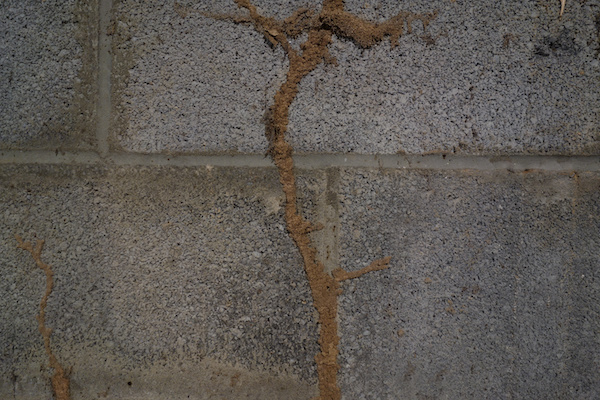Causing up to $5 in home damage yearly, termites are major concerns for homeowners in areas common for termite infestations.
Unfortunately, there aren’t many signs of termites that may indicate you have an infestation. Because they chew a home’s wood from within, most homeowners don’t notice a problem until they find significant damage.
Some termites, like subterranean termites, spend most of their time in outdoor colonies. Subterranean termite mud tubes can help you locate the source of the infestation and even hint at the pests’ location on your property!
What are Subterranean Termites?
As their name suggests, subterranean termites reside underground. Instead of living in aboveground mounds or even inside the wood they consume, these pests create below-ground cavities to house eggs, workers, their king, and queen.
Compared to other termite species, subterranean termites are much smaller, reaching only up to 3/8th of an inch. However, don’t let their size fool you! Subterranean termites are one of the most destructive species.
In New York, subterranean termites are the most prolific species. In fact, you can find them in every state across the country, even in the chilly Alaskan weather.
Plus, these colonies can house multiple termites within. Well-established colonies may have tens of thousands of insects swarming inside or even upwards of a hundred thousand or more! When left unattended, their population can reach millions!
Because these pests live far under the dirt, you won’t see them unless you do some digging or find them sneaking through the wood in your home. However, other signs can point you in their destructive direction.
Subterranean Termite Mud Tubes
Termites may be hard to spot, but they’re not impossible to see when they invade your home. Even the craftiest of insects leave behind clues that disclose their location.
For example, drywood termites primarily live and populate the wood they eat. A full-sized colony can inhabit your home and cause immense structural damage under your nose!
Homeowners find traces of these pests whenever they expel waste from their wooden tunnels. Also called frass, termite waste is an unnecessary nuisance to drywood termites that take up valuable living space.
If you spot small tan or brown pellets collected under a hole or crack outside a wall, windowsill, or other wooden structure, drywood termites could be inside, feasting on your home’s wooden support beams.
However, subterranean termites utilize their waste in many different ways. Subterranean termite mud tubes are crafted from the dirt around your home and the frass they create from their wood-based diets.
Waste not, want not!
Mud Tube Appearance
Despite being a key indicator of subterranean termite infestation, these tiny tubes may look harmless at first glance. Outside, you could mistake these mud tubes for regular dirt streaks or the homes of less destructive pests like mud daubers.
Termite mud tubes are small, no wider than an inch in diameter. Most aren’t too long, but some can exceed a foot in length, especially if you have a severe infestation within your wall and yard.
Composed of feces, dirt, and wood, subterranean termites use their salvia to pack their dirt tunnels. These structures are light to dark brown and robust enough to sustain the weight of a few hundred termites shuffling through each day.
While they can support these small creepy crawlers, termite mud tubes aren’t strong structures. You can easily knock down a mud tube with ease and disrupt its doorway into your home.
But they won’t stay away for long! Termites work fast; they can cause significant home damage within a year and are quick builders too. When you knock down a termite tube, a group of workers quickly repair the damage within a few hours.
Types of Termite Tubes
Subterranean termites utilize these dirt structures in various ways. While they’re a crucial entry point into your household, these crafty pests rely on the pathways for different functions in your home.
Some termite tubes extend from your roof or the top of wooden items, like a desk, pantry, shelves, or attic beams. You could spot these subterranean termite mud tubes if the wooden items are already infested with termites.
Termites use these mud tubes to join other tunnels on the ground or soil to reconnect to the workers below.
Many termites create tubes that they regularly travel and forage through. These tunnels will typically be more robust than others to support the frequent travel and transport of food back to the main colonies.
Subterranean termites will even create mud tubes just to look around! Most homeowners spot vacant tubes inside or outside their homes, with termites never returning to repair any damage we left.
These structures are purely to probe your home for resources and see what spoils you have they can steal– or eat. If you find empty tubes like this, termites could have moved further inward and caused more damage to your home.
So, You Have Subterranean Termite Mud Tubes. What Now?
As one of the most destructive termite species in the United States, with the subspecies the Formosan termites destroying wood at an exceptionally fast rate, subterranean termites aren’t something you’ll want in your home for long.
However, DIY methods aren’t recommended for these destructive pests. Termites often require pesticides and baits not commercially available for the average consumer, meaning over-the-counter methods may not work.
Termites can cause some damage too, and if you don’t know where the active infestation lies, they could continue to eat through your home unabated. Whenever you have signs of termites like subterranean termite mud tubes in your home, you need to contact a pest control company promptly.
Give us a call whenever you suspect termites. We can inspect your home to look for these pests and eliminate them from your home in no time!

